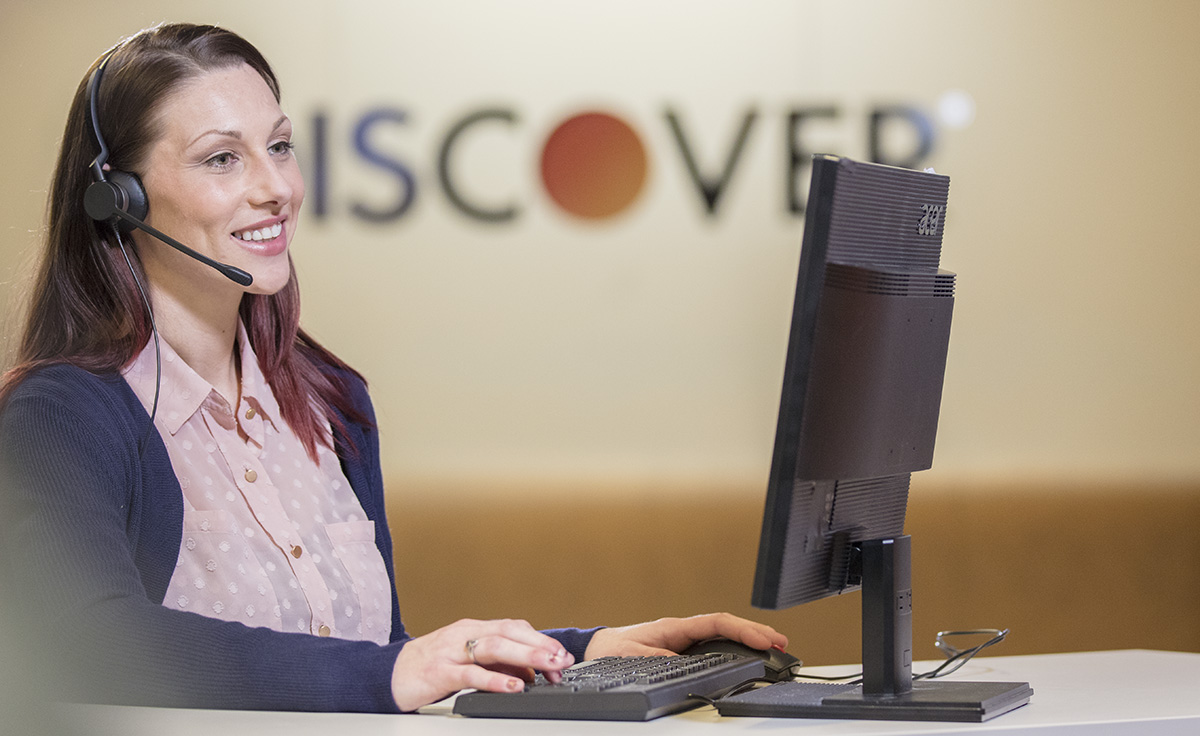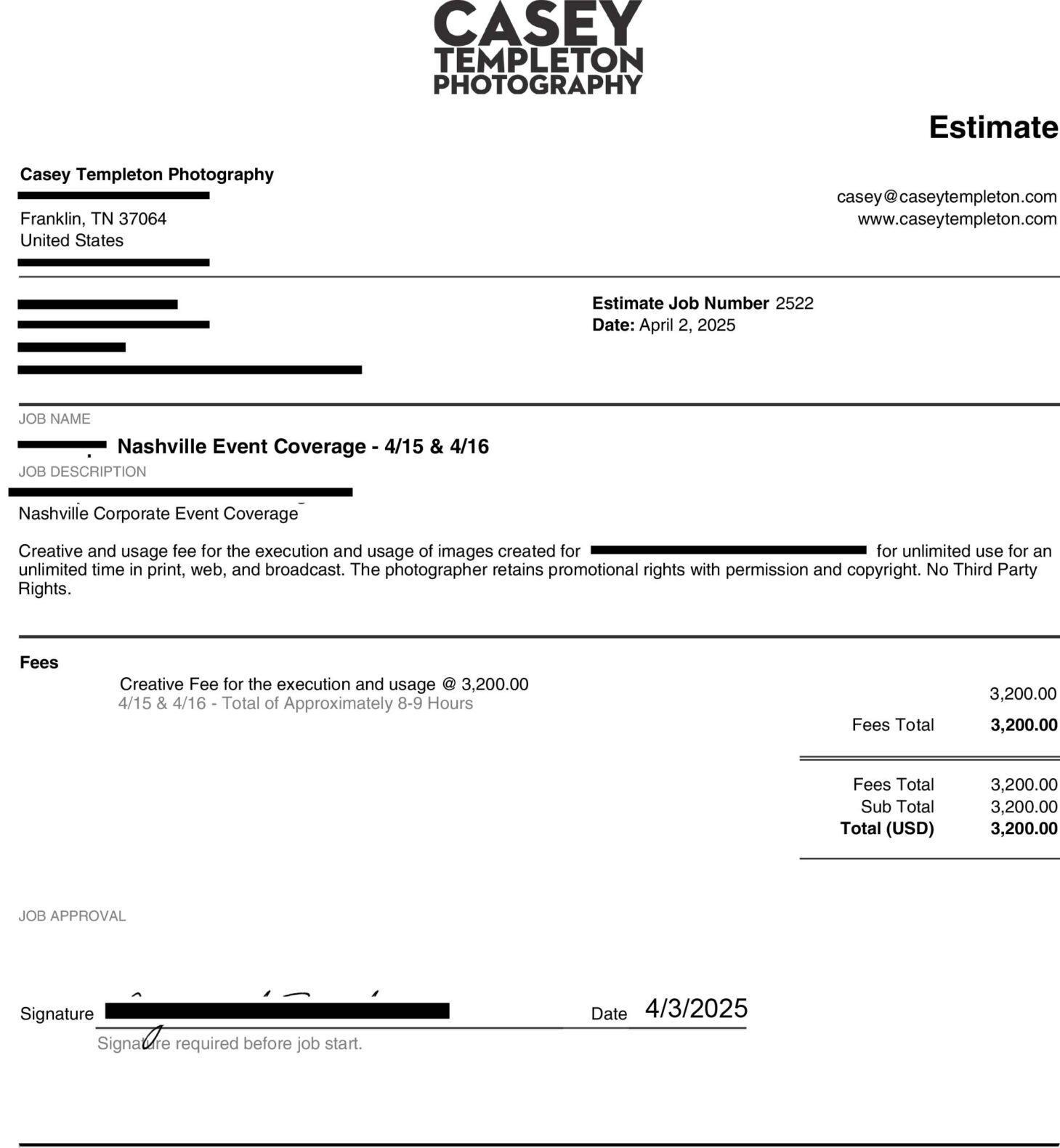Finding the right photographer for your company is key, but understanding the photography usage rights agreement specified in your contract saves you a boatload of trouble. As a business owner, you know the importance of high-quality images to your visual marketing and advertising campaigns. But you’re not a legal expert, and any contract can be confusing, especially when you’re working with a professional photographer.
In this article, I’m going to break down everything you need to know about photo rights as the client of a commercial photographer. Continue reading to learn about the copyright ownership of photographs, what a photo license is, different types of photography rights, and more.
When You Hire a Photographer, Who Owns the Pictures?
You’re paying your photographer, so the pictures are yours, right? Oftentimes, that’s not the case. When you hire a professional photographer, the engagement is defined as a contractual relationship. That means you are paying for their services, not the actual pictures.
In a typical contract, the photographer retains ownership of the photos. Photographers can grant you an unlimited license, which allows you to use the photos in any way. But legally, the photo copyrights remain under their ownership. The only time you’ll own the photo rights is if you hire an employee dedicated to photography or have a staff member take the photos on their iPhone (which I don’t recommend if they’re not experienced professionals).

Are Photos Intellectual Property?
Yes, photos are intellectual property. Intellectual property is defined as the creation of the mind. Professional photographers certainly use their minds to frame, compose, and capture iconic images for your corporate brand.
There are two different components to photography rights: copyrights and licensing.
Copyright Ownership of Photographs
Copyrights protect the owner of the image and are the first element of photo rights to understand. As I mentioned previously, unless the contract specifies otherwise, the photographer retains copyright ownership of their images.
What does it mean to own the copyrights to an image? To protect the owner, the U.S. Copyright Act grants them exclusive rights to:
- Reproduce the photo
- Prepare derivative works, or new works based on the photograph
- Distribute copies of the image by sale or transfer of ownership, or by rental, lease, or lending
- Display the photo publicly
Photo Licensing
Now to the important part for you, the client: photo licensing. In general, photo licensing is when a photographer (or anyone else who owns the copyright) grants permission to use a photo. The permission is legally defined through a photo license. Copyright owners can license photos to a variety of sources, like stock photo libraries, magazines, publications, and other platforms, to earn money from their work.
As it applies to commercial photography, the client and photographer typically agree on an exclusive license. I’ll break down the different sections of a license later in this post, but an exclusive license means only the licensee can use the photos.
The photographer retains the copyright, but often they only want to add the photos to their portfolio. Clients pay for the photographer’s services and, in return, obtain a license to use the photos for marketing, advertising, promotion, and other uses.

Types of Photography Rights
When a photographer decides to license their images, there are multiple considerations. Photo licensing isn’t one-size-fits-all.
Typically, there are three components to a photo license:
- Type of usage
- Exclusivity, and
- Duration
| Type of Photography Rights | Explanation | Example |
| Usage | Determines how the licensee is allowed to use images | Commercial or editorial use |
| Exclusivity | Determines whether the client retains sole rights to use images or if the photographer can license them to other people at the same time | Exclusive or non-exclusive |
| Duration | Defines how long the licensee retains the rights | One year, three months, unlimited, etc. |
Types of Usage
The type of use determines how the licensee is allowed to use the images. Two main use types you’ll find are commercial and editorial.
- Commercial use is when you use images to sell or promote a business and its products and/or services.
- Editorial use is when the images are used in a magazine, newspaper, or other editorial publication.
Exclusivity
Some photographers license the same image out to multiple sources, while others give exclusive rights to one party.
- Non-exclusive rights give an individual or entity the right to use the photos in a predefined way. The photographer can grant non-exclusive rights to several people at the same time.
- Exclusive rights grant one source the sole rights to use the images. The photographer cannot license the photos to anyone else and often cannot use the photos for anything other than their portfolio.
Duration
The final consideration when licensing photos is for how long the licensee has the rights. License duration can range from several months to unlimited, meaning the licensee has the right to use the images as long as they would like.
A typical commercial photography license will grant 1-2 years of usage rights. When thinking about your business’s marketing and promotional plans, it’s a good idea to have fresh images taken every few years.

What is a Photography Usage Rights Agreement?
A photo usage rights agreement is a written legal contract granting an individual or entity the rights to use images for which a photographer owns the copyrights. This is synonymous with a photo license, though on rare occasions a photographer may also transfer the copyright to the client.
When working on a corporate photography project, a photographer usually grants the client exclusive rights to all of the photos.
While the license agreement is secured in the contract, the actual licensing process looks something like this:
- The photographer takes the photos, which they possess the copyright to
- The photographer grants the client permission to use the photo via a license
- The client can share images online and in person, but they cannot transfer the images to any third party

Types of Photo Licensing Agreements
There are various types of photo licensing agreements, distinguished by factors such as exclusivity and payment structure. Each option agreement comes with pros and cons depending on the situation, and it’s on you to determine which is best for your project.
The different types of photo licensing contracts include:
- Exclusive/Non-Exclusive
- Royalty-Free
- Rights-Managed
- Unlimited Use
- Creative Commons
| Type | Definition |
| Exclusive/Non-Exclusive | Determines how many people (or clients) a photographer may grant the rights to use a specific image or set of images. |
| Royalty-Free | Allows the licensee to purchase image rights at a flat rate without any additional restrictions on, or charges for, usage. |
| Rights-Managed | Grants the licensee limited and restricted use of an image or library of images, defined by specific terms. |
| Unlimited Use | Provides the licensee unlimited rights to an image or set of images, with no restrictions on usage or time. |
| Creative Commons | A free-to-use framework that allows creators to grant rights to anyone (non-exclusive) who wants to use the image under specific conditions, often not tied to financial compensation. These conditions can include a requirement for attribution anytime the photo is used or a restriction on commercial use. |

Exclusive/Non-Exclusive
The most common type of agreement is centered around the exclusivity of photo rights. Exclusive and non-exclusive licensing determines how many people (or clients) a photographer may grant the rights to use an image or set of images.
- Exclusive: Grants usage rights to a sole licensee. No one else can purchase or use images for any other purpose.
- Non-Exclusive: Determines that the licensee is not the sole holder of usage rights, and the photographer can license their images to anyone.
Royalty-Free
Royalty-free licensing agreements enable you to purchase an image at a flat rate without any usage restrictions. The “royalty-free” declaration means you don’t have to pay any fees, also known as royalties, to the photographer every time you use an image (or use an image in a way that’s outside your agreement).
The photographer remains the licensor and retains ownership of the images.
Rights Managed
A rights-managed agreement grants limited and restricted use of an image or set of images. The usage permission is usually determined by specific factors like duration, region, project scope, or type of medium.
Rights-managed contracts offer more customization, which can lead to more usage restrictions or a higher price.
Unlimited Use
In an unlimited use agreement, you (the client) can use the images with no restriction. That includes all digital and print media, with limited boundaries. The image or set of images can be used for editorial, commercial, or personal use.
As with royalty-free agreements, the photographer is still the owner of the image and the licensor. You don’t have the right to sell the work, only to use it in any way you’d like.
Creative Commons
Creative Commons licenses allow copyright holders to grant permission to use their work without requiring individual requests for every use. This free-to-use framework allows creators to share images with others under specific conditions, often not tied to financial compensation and not restricted by traditional copyright.
As a brand, this option allows you to find and use images online, provided you follow the attribution requirements. For example, a photographer may host a library of photos with Creative Commons licensing that allows you to use an image as long as you attribute the photographer.

Terms of an Image Licensing Agreement
As a client, whether you’re a business owner, marketing manager, advertising consultant, or anyone else working directly with a business photographer, you need to understand the numerous terms that define a photography usage rights agreement.
Every contract is unique and tailored to the client and photographer’s needs. There are a few common terms included in an image licensing agreement, including:
- Time period (length of time)
- Quantity
- Exclusivity
- Geographic region
- Market
- Usage
- Media
- Body of Works vs. Selects
| Term | Definition |
| Time period (length of time) | Sets the duration rights are granted for clients to use an image or a library of images. |
| Quantity | Establishes how many times an image or set of images can be used. |
| Exclusivity | Determines whether a client retains sole possession of rights to use an image or set of images. |
| Geographic region | Defines the physical area where an image can be used and seen. |
| Market | Defines the organization’s market, value, intended use, and industry. |
| Usage | Limits how images can be used. |
| Media | Defines where an image will be seen and through what medium |
| Body of Works vs. Selects | Body of works refers to an entire image library, while selects refer to specific images within a library. If a photographer only grants a client rights to selects, the client can’t use other images from a shoot not defined as selects. |

Time Period (Length of Time)
The time period, or length of time, defines the duration you can use an image or a library of images. One year is a common length of time for an image to be licensed. Some contracts, like an unlimited use agreement for a small business, might not have a defined time period.
When you’re working on your contract, it’s important to specify “from the date of first use” or “from the day of shoot” to define when the time period begins.
Quantity of Usage
Quantity establishes how many times an image can be used. This term is more applicable to licensing stock photos or situations where a photographer wants to license out an image to multiple clients.
- Limited quantity grants you a limited number of times to use an image or set of images within the defined time period.
- Unlimited quantity allows you to use an image or set of images as many times as you’d like, within the defined time period. That doesn’t mean you own the rights, nor that you have an unlimited amount of time with them. It only means you can use images or a library as many times as you’d like in the duration of the contract.
Exclusivity
We touched on this a bit when defining the types of rights, but exclusivity determines whether you retain sole possession of rights to use an image or set of images.
- Exclusive agreements grant you sole rights. The image or set of images can’t be sold to or used by anyone else for the duration of the contract.
- Non-exclusive agreements grant you rights, but don’t restrict anyone else. The image or set of images can be sold to and used by other people at any time, regardless of the contract.

Geographic Region
Geographic region is a term that defines the physical area where an image can be used and seen. This is more often included in contracts for advertising firms or other larger creative agencies.
The most common geographic region permissions are:
- National: Only used in the nation where the agreement was made. In the United States, national means the US and provinces only.
- North America: Can be used in the US and provinces, Canada, and Mexico.
- Global or International: Can be used anywhere throughout the world and on the internet
- Local: Can only be used in a specific city or area
- Regional: Can only be used in a specific region
- By country: Usage rights can be determined on a country-by-country basis
Market
Your organization’s market, value, intended use, and industry can be defined in a usage rights agreement and impact the cost of an engagement. Again, this applies more to larger corporations or advertising agencies representing clients. Most small businesses don’t have to worry about this.
There are three main “markets” that define the intended use of images:
- Consumer: Markets to people who buy things (consumers). Because images are used to sell, photographers usually charge more in a consumer-focused market.
- Trade: Markets to people who sell things to other people. Trade advertising has less exposure and comes at a lower cost than consumer.
- Editorial: Informational use without a commercial purpose. These images are usually included as supplemental visuals in magazine articles or textbooks, for example.
Usage
In terms of a photo licensing agreement, usage is a more specific definition of how images will be used. This gets more granular than the “types of usage” rights covered earlier in this resource.
Common usage terms include:
- Advertising: Used to sell something, like an ad or billboard
- Promotional: Used to promote something, like an event or trade show
- Public relations: Used to drive awareness to a brand with less of a commercial intent
- Corporate: Used for annual reports or internal materials
- Editorial: Used for informational purposes, like an article in a magazine or a textbook.

Media
Media defines where an image will be seen and through what medium. This breaks usage down to more specific terms. Again, this granular type of definition is more common in larger engagements.
When setting media terms in your contract, consider the following:
- Any and all media: Covers everything, including all print, electronic, and broadcast media
- All print: Anything printed onto paper that you can hold in your hand (ex. Newspaper, magazine, direct mail, etc.)
- Newspaper
- Magazine
- Collateral: Brochures, mailers, etc.
- Direct mail: Pieces mailed directly to people
- Point-of-sale (POS) or point-of-purchase (POP): Images displayed where the product is sold. Some examples include banners, signage, counter cards, displays, in-store posters, and table tents.
- Out-of-home (OOH) or Outdoor: Anything seen outside of your home, including billboards, bus sides, rail cards, and more.
- Electronic: Media that isn’t printed (internet, CDs, digital ads, etc.)
- Internet: Global internet use, including social media, your website, and more.
Body of Works and Selects
The final “terms” are body of works and selects. These aren’t entirely “usage terms”, but define which images you’re allowed to use.
- Body of works refers to all images shot for the project. You can use the entire image library.
- Selects refers to specific images from the project, but not all of them. If you’re only granted rights to selects, you could face consequences for using other images from the shoot.
Why Do You Need A Photo Licensing Contract?
A photo usage agreement covers your bases as a business owner working with a photographer, outlining the terms by which you’re allowed to use a defined image or set of images.

Here are a few reasons why you need a written agreement:
- You can’t legally use images from a commercial photo shoot without obtaining written permission from your photographer. Unlike wedding or personal photo shoots, commercial photography pricing doesn’t often include free use of the entire image library. Because you’re using the image to promote your business and generate profit, your photographer understands their value in the process. Whether baked into their total rate or a separate licensing fee, photographers charge the amount of value their image generates over a defined period of time.
- A written agreement avoids any potential legal issues regarding the use of images from a shoot. Even if it’s only requiring credit when using the photo on social media, defined terms make sure you don’t incur any fees or penalties for improper use.
- Exclusive photo rights provide you with images your competitors can’t use. An exclusive photo rights agreement grants you sole rights to use a defined set of images. If you don’t pay for exclusive rights to images, your photographer can turn around and license relevant images to your competitors. While you hope that would never happen, it’s better to protect yourself.
How Much Do Photo Rights Cost?
There is no one-size-fits-all approach to pricing photo usage rights. You can find anything from a one-time fee for a stock image to extremely specific usage terms.

In general, there are a few things to consider when assessing a photographer’s licensing fee:
1. Value and experience of the photographer. A photographer knows their value, especially if they have a robust portfolio and a proven track record. Newer photographers with little experience will likely offer better rights at a lower price.
2. Value of your business and industry. Large international brands advertise in a much larger market than smaller local businesses. Licensing fees take into consideration the price that similar photos have demanded in the past. More exposure leads to higher value and, subsequently, a steeper price tag.
3. Type of usage. The type of usage is often tied to exclusivity and time. An image library exclusively licensed to your company is more valuable because you can use the photos anyway you want, and no one else can use them. One-time use rights for a photo that can then be licensed by anyone else have a lower value.
Combine all of those factors and work with your photographer to settle on a fair agreement. As with all corporate and commercial photography pricing, there is no set cost for usage rights.
How To Establish a Photography Licensing Agreement
You should discuss and establish a photography licensing agreement before committing to hiring a photographer for your brand. Once all terms are agreed upon, your photographer will draft an official legal document. Sometimes, as a client, you may prefer to create the agreement together.
You can break the process into three steps or sections:
- General Information
- Grant of Rights, Usage Restrictions, and Other Required Details
- Additional Options

1. General Information
The first few items to complete cover who is involved and the purpose of the document. This includes:
- Parties. The full legal names and details identifying the licensor/owner (photographer) and licensee (you, the client).
- Background information. This is a concise overview of the engagement. It covers anywhere from where the images were shot to who owns them and the reason for licensing.
2. Grant of Rights, Usage Restrictions, and Other Required Details
This section is the core component of your contract. It specifies all essential details, defines and grants rights, highlights usage restrictions, and sets the cost and timeline.
- Type of license/agreement. The definition of the agreement specifies information like exclusivity and general rights (ex. Royalty-free, unlimited use, etc.).
- Price. The total cost of the agreement including a full breakdown of rates depending on the size and scope.
- Usage or permissions. Specific usage permissions and restrictions are defined as clearly as possible. For example, you may be granted rights to use photos on your website and social media, but not print ads or billboards.
- Timeline. The agreed-upon time for the contract and how long you can use the images.
3. Additional Options
While the core components above make up the meat of most agreements, there can be additional information and considerations depending on the project. Here are some items to look out for or inquire with your photographer about.
- Copyright and ownership: A clear definition of who owns the images and copyright. Most photographers retain this, though some agreements hand over ownership to you.
- Attribution: Some photographers may include a stipulation that you attribute them when using the photograph. For example, a photographer could include a requirement to tag their account on Instagram posts using their image.
- Edits: Photographers may choose to set limitations or define rights for editing or altering images.
- Digital rights management: If a photographer has specific requirements for protecting metadata or other technical components of the image, they may include a section in your agreement.

Photo Licensing Agreement Template
As with many components of professional photography for business branding, there is no “one-size-fits-all” template for a photo licensing contract. Some photographers opt to include photo rights within the general estimate, while others draft up a photography license agreement separate from the high-level invoice.
Photography Usage Rights Agreement Example
The image below is a screenshot of a contract for two days of CTP corporate event coverage in Nashville with a client. Notice how we bake usage rights and licensing into the overall estimate. Within this agreement, we define:
- General project overview: Outlining the terms of corporate event coverage in Nashville
- Housekeeping items: The date of the agreement and the job number
- Information about services: Specific days for physical coverage (4/15 & 4/16)
- Pricing: In this example, physical shooting, delivery, and image rights are grouped into one creative and usage fee for the execution and usage
- Rights and licensing terms: Unlimited use for an unlimited time in print, web, and broadcast; no third-party rights
- Copyright ownership of photographs: The photographer (CTP) retains promotional rights with permission and copyright

Free Photo Licensing Agreement Template [DOWNLOAD]
Linked below is a sample photo licensing agreement that you can download for free! The template is based on CTP’s estimate/usage rights agreement combination.
Here’s an overview of the structure and how to apply it to your needs:
- Licensor’s information: Name/Business name, address, phone number, email, and website of the person or party that provides photography services and/or grants the license
- Licensee’s information: Name/business name, address, phone number, and email address of the person or party that is receiving images and usage rights
- Housekeeping items: The job number and date of the agreement being signed
- Job name: Overall title for the services (CTP’s reads like an email subject line: “Client Nashville Event Coverage – 4/15 & 4/16”)
- Name of services/event: Typically the name of the client and project (ex. Client Branding Photoshoot)
- Service/event subheading: What type of services are provided (event coverage, on-site photoshoot, production stills, etc.)
- Description: An overall description of the services, usage rights, pricing arrangement, and any other details
- Fees: List all fees (ex. execution, creative, usage, travel, etc.) and the style of pricing (ex. hourly, day rate, etc.)
- Pricing estimate total: Include any additional taxes or charges, and calculate the total estimate
- Signature: The licensee signs the contract agreeing to the terms before the project can start
As I mentioned before, there are other ways to create a usage rights contract. Other examples explicitly define usage rights in a document separate from the estimate.
Tips for Navigating Photo Rights
Photography rights are complex, and if you don’t pay attention, you may not be able to use images the way you want.
As an experienced commercial and corporate photographer, I’ve worked on countless usage rights agreements in various industries and with businesses of all sizes. Here are a few tips, for clients, on navigating photo rights that I’ve picked up along the way.
- You don’t have to take down old ads when an agreement’s timeline ends.
- Some photographers include licensing in their creative fee; others separate it.
- Get as specific as possible when defining terms.
- Understand the value of your photographer.
You don’t have to take down old ads when an agreement’s timeline ends
Licensing agreements only apply to new content. Once the defined length of time runs out, you can no longer create new content using those images. But that doesn’t mean you have to remove any previous usage of the image that came within the terms of the agreement.
Some photographers include licensing in their creative fee; others separate it
Sometimes it depends on the business size. Larger clients may want licensing as a separate line item, while smaller businesses prefer it all to be wrapped in one total fee. It all depends on the client and photographer’s preference.
Get as specific as possible when defining terms
You have to make sure to cover any way you intend to use images. While it can feel like overkill to drill into specifics, that’s the only way to tailor the contract to your needs and cover your bases legally.
Understand the value of your photographer
Licensing fees help cover the value a photographer feels their image and time provide to you as the client. When you use an image to sell your product, that image (and the photographer’s time, skills, and abilities) generates profit.
If a fee seems expensive or you’re surprised to see additional licensing fees in your contract, remember the complete value the photographer and their work provide your brand.

Work With Casey Templeton Photography To Ensure Your Photo Rights Are Covered
Now you have a better understanding of photo usage rights and image licensing. As a business, your main goal is to obtain a diverse library of high-quality images that you can use to promote your organization. The biggest takeaway from this post should be to ensure you secure exclusive rights for the images from your session.
Casey Templeton Photography works with all of our clients to make sure they understand the terms of the contract and answer any questions regarding the rights to use photos. If you want to learn more about photo usage rights or inquire about a project, fill out our contact form to get the conversation started.
